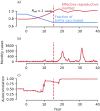Detecting critical slowing down in high-dimensional epidemiological systems
- PMID: 32150536
- PMCID: PMC7082051
- DOI: 10.1371/journal.pcbi.1007679
Detecting critical slowing down in high-dimensional epidemiological systems
Abstract
Despite medical advances, the emergence and re-emergence of infectious diseases continue to pose a public health threat. Low-dimensional epidemiological models predict that epidemic transitions are preceded by the phenomenon of critical slowing down (CSD). This has raised the possibility of anticipating disease (re-)emergence using CSD-based early-warning signals (EWS), which are statistical moments estimated from time series data. For EWS to be useful at detecting future (re-)emergence, CSD needs to be a generic (model-independent) feature of epidemiological dynamics irrespective of system complexity. Currently, it is unclear whether the predictions of CSD-derived from simple, low-dimensional systems-pertain to real systems, which are high-dimensional. To assess the generality of CSD, we carried out a simulation study of a hierarchy of models, with increasing structural complexity and dimensionality, for a measles-like infectious disease. Our five models included: i) a nonseasonal homogeneous Susceptible-Exposed-Infectious-Recovered (SEIR) model, ii) a homogeneous SEIR model with seasonality in transmission, iii) an age-structured SEIR model, iv) a multiplex network-based model (Mplex) and v) an agent-based simulator (FRED). All models were parameterised to have a herd-immunity immunization threshold of around 90% coverage, and underwent a linear decrease in vaccine uptake, from 92% to 70% over 15 years. We found evidence of CSD prior to disease re-emergence in all models. We also evaluated the performance of seven EWS: the autocorrelation, coefficient of variation, index of dispersion, kurtosis, mean, skewness, variance. Performance was scored using the Area Under the ROC Curve (AUC) statistic. The best performing EWS were the mean and variance, with AUC > 0.75 one year before the estimated transition time. These two, along with the autocorrelation and index of dispersion, are promising candidate EWS for detecting disease emergence.
Conflict of interest statement
I have read the journal’s policy and the authors of this manuscript have the following competing interests: JJG is a principal in Epistemix Inc., which has been licensed by the University of Pittsburgh to develop commercial applications of the FRED modeling technology mentioned in this study.
Figures







Similar articles
-
Anticipating infectious disease re-emergence and elimination: a test of early warning signals using empirically based models.J R Soc Interface. 2022 Aug;19(193):20220123. doi: 10.1098/rsif.2022.0123. Epub 2022 Aug 3. J R Soc Interface. 2022. PMID: 35919978 Free PMC article.
-
Anticipating epidemic transitions with imperfect data.PLoS Comput Biol. 2018 Jun 8;14(6):e1006204. doi: 10.1371/journal.pcbi.1006204. eCollection 2018 Jun. PLoS Comput Biol. 2018. PMID: 29883444 Free PMC article.
-
Prospects for detecting early warning signals in discrete event sequence data: Application to epidemiological incidence data.PLoS Comput Biol. 2020 Sep 22;16(9):e1007836. doi: 10.1371/journal.pcbi.1007836. eCollection 2020 Sep. PLoS Comput Biol. 2020. PMID: 32960900 Free PMC article.
-
Early warning signals of infectious disease transitions: a review.J R Soc Interface. 2021 Sep;18(182):20210555. doi: 10.1098/rsif.2021.0555. Epub 2021 Sep 29. J R Soc Interface. 2021. PMID: 34583561 Free PMC article. Review.
-
New technologies in predicting, preventing and controlling emerging infectious diseases.Virulence. 2015;6(6):558-65. doi: 10.1080/21505594.2015.1040975. Epub 2015 Jun 11. Virulence. 2015. PMID: 26068569 Free PMC article. Review.
Cited by
-
Performance of early warning signals for disease re-emergence: A case study on COVID-19 data.PLoS Comput Biol. 2022 Mar 30;18(3):e1009958. doi: 10.1371/journal.pcbi.1009958. eCollection 2022 Mar. PLoS Comput Biol. 2022. PMID: 35353809 Free PMC article.
-
An early warning indicator trained on stochastic disease-spreading models with different noises.J R Soc Interface. 2024 Aug;21(217):20240199. doi: 10.1098/rsif.2024.0199. Epub 2024 Aug 9. J R Soc Interface. 2024. PMID: 39118548 Free PMC article.
-
Application of early warning signs to physiological contexts: a comparison of multivariate indices in patients on long-term hemodialysis.Front Netw Physiol. 2024 Mar 26;4:1299162. doi: 10.3389/fnetp.2024.1299162. eCollection 2024. Front Netw Physiol. 2024. PMID: 38595863 Free PMC article.
-
Active probing to highlight approaching transitions to ictal states in coupled neural mass models.PLoS Comput Biol. 2021 Jan 25;17(1):e1008377. doi: 10.1371/journal.pcbi.1008377. eCollection 2021 Jan. PLoS Comput Biol. 2021. PMID: 33493165 Free PMC article.
-
Anticipating the Novel Coronavirus Disease (COVID-19) Pandemic.Front Public Health. 2020 Sep 3;8:569669. doi: 10.3389/fpubh.2020.569669. eCollection 2020. Front Public Health. 2020. PMID: 33014985 Free PMC article.
References
-
- Hohenberg PC, Halperin BI. Theory of dynamic critical phenomena. Reviews of Modern Physics. 1977;49(3):435 10.1103/RevModPhys.49.435 - DOI
-
- Bailey NTJ. The Elements of Stochastic Processes with Applications to the Natural Sciences. vol. 25 John Wiley & Sons; 1990.
-
- van Kampen NG. Stochastic Processes in Physics and Chemistry. North Holland; 1981.
-
- Strogatz SH. Nonlinear Dynamics and Chaos: With Applications to Physics, Biology, Chemistry and Engineering. Westview Press; 2001.
Publication types
MeSH terms
Grants and funding
LinkOut - more resources
Full Text Sources

